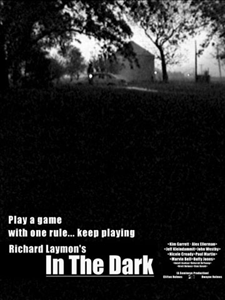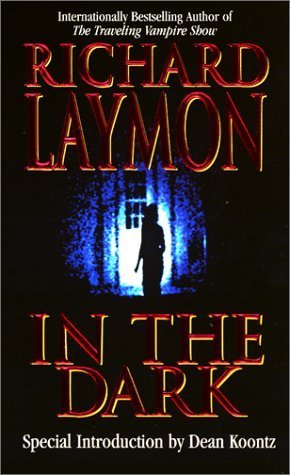
Source: Richard Laymon Kills!
If you've followed me for any length of time, you know that I love horror. Whether it's movies, or novels, or short stories, or even video games, I'm a sucker for giving it a try. It's my favorite genre, and one of my favorite writers within that genre is Richard Laymon.
Now, Laymon's not for everybody. He has a very specific style that is uniquely his own, and he fills his books with a diverse array of weirdos, randos, and perverts that ride forth from his subconscious and lay siege to our fragile psyches. But one of the things I love about him is that most of his stories are very straightforward: they could happen.
That's not to say everything Laymon wrote is feasible, but even when he's tackling hoary old tropes like vampires, Laymon puts his own spin on everything. For Laymon, the game wasn't to convince you that vampires walked among us, it was to convince you that if they did, this is probably how they would behave. That's the heart and soul behind books like The Stake, The Travelling Vampire Show, and Bite. They're all stories about ordinary people who might be dealing with vampires, not vampire stories in and of themselves.
In The Dark isn't a vampire story. It's one of his longest books, but like everything else the guy wrote, it flies by like a roller coaster ride. By the time you step off and try to orient yourself, you can't believe it's over. In The Dark is Laymon's exploration of how curiosity, desperation, and greed could transform us in ways we couldn't possibly anticipate. If I suggested you drive to a cemetery in the middle of the night, find the groundskeeper's house using nothing but a flashlight, break in through the back door, navigate upstairs, change into a set of lingerie I had provided, and lay in a coffin for 30 minutes, your response would likely involve a lot of profanity and requests for me to perform biologically-impossible acts with myself.
On the other hand, what if I had already asked you to perform other, smaller, more trivial tasks, like solving riddles and finding hidden items on a scavenger hunt, and each and every time, you had earned twice as much money as the previous payment? The last time you played, I paid you with 32 crisp, real hundred dollar bills; ergo, by completing this simple task, you would earn six thousand four hundred bucks in cold, hard cash, and you know I'm good for it. You also could really use the money, because you're a small-town librarian who scrapes and scrimps to make every penny of your meager salary count.
Well, that's a different story, isn't it...?
Richard Laymon's In The Dark is a kind of cross between the Saw franchise and the Thai film 13 Beloved (remade in the US in 2014 as 13 Sins). In both cases, a mysterious individual challenges seemingly-random individuals to perform specific tasks which are often degrading or life-threatening, in exchange for some prize. In the Saw movies, the prize is generally survival, while in 13 Beloved, the prize is an ever-increasing amount of money. The genre for this kind of story is known as "Game Horror", and you can find examples of it going all the way back to The Most Dangerous Game from the 1920s.
While the premise itself is nothing new, it is worth noting that Laymon wrote In The Dark in 1994, thus beating Saw, Would You Rather?, Truth or Dare, 13 Sins, and the other modern-day takes on this theme to the punch by a solid decade or more. Six years later, writer/director Clifton Holmes and his producer brother Dwayne sought to bring Laymon's story to the screen, and while they were never able to complete their work, what survives is an amateur production that is monstrously more entertaining and enjoyable than it has any right to be. This is Richard Laymon's In The Dark, and you can watch the full one hour and forty-six minute production right here, courtesy of our dear old friends at YouTube:
If you sit down to watch it, it's good to know a few things going in. When I said the film was incomplete, I wasn't lying, but it's not as tragic as you might suspect. All of the principle photography and editing work was finished -- what remained unfinished due to a lack of funds was any sort of ADR work for the dialog, sound effects, or film score aside from a single piece of music during the title sequence. Everything you hear is the original audio as captured during the live recordings. This makes it difficult to hear all of the lines, as environmental sounds like lapping waves and blowing wind occasionally obscure the audio.
It's also filmed entirely in black-and-white (with one very notable exception), which gives it the feeling of an old episode of The Twilight Zone. The Holmes brothers made this decision because they didn't have the budget to shoot on film, and color video footage in the late 90's lacked the fidelity they were seeking. Black and white video stock, however, was not only cheaper, but also offered a superior contrast and picture quality. This was especially important considering how much of the story takes place at night.
For actors, the Holmes' used performers they scouted from local Chicago theatre troups, and these kids do a decent enough job with the material to keep the story flowing, but Kim Garrett's performance as Jane is an absolute show-stopper. The movie literally lives or dies by her, since she's the main character and the one the camera's following for the bulk of the production, but she sells everything and was willing to completely disrobe for a couple of scenes which show just how completely the guy playing the games has gotten his claws into her. There's no sex, and the nudity is very brief and not at all erotic (not to mention entirely in black-and-white), but still tastefully done. Alex Ellerman, who plays the male lead of Brace, is mostly good too, although he comes off a bit goofier in the film -- in the book, he's more awkward and stumbling around Jane, and Ellerman feels more like a confident guy trying to play the introvert. Oddly enough, though, this isn't necessarily a bad thing. One of the primary questions the reader (and thus, the viewer) has throughout the story is just how Brace fits into the whole thing: is he truly innocent as he professes, trying to help Jane through a few of her tasks because he cares about her, or is he more deeply involved than he's letting on, enjoying a ring-side seat to Jane's various games? With Brace in the novel, I got a very clear sense from early on of where he fit in terms of the story. In the movie, Ellerman's performance makes it far more difficult to get a read on things, which kind of works in his favor. Whether this was a conscious choice on Ellerman's part, or the result of Clifton's direction, I'm a huge fan of how it turned out.
And speaking of how it turned out...holy cow, we need to talk about that ending. No spoilers, but I would be remiss in my duties as a writer and a reviewer if I didn't bring this up. Simply put, the Holmes brothers changed the ending, and I could not be happier. While I love Laymon as a writer, I'm perfectly happy to admit he sometimes failed to stick the ending, and In The Dark, despite being one of my favorite stories of his, is guilty of this sin. It concludes the story, but it feels like Laymon wrote himself into a corner and took the only way out that he could see.
The film, on the other hand? Holy shit, they not only stick the ending, but as far as I'm concerned, this is the way the book should have ended. Laymon saw this rough cut of the film before he died, and he had nothing but praise for it and Clifton and Dwayne themselves. I think part of that has to come from the change made to the ending. It's far darker than the book's, and much like King's reaction to Frank Darabont's re-write of The Mist's conclusion, I'd like to think it's the conclusion Laymon would have used if he'd come up with it six years earlier.
How successfully did the Holmes brothers capture the feeling of the book? Well, when Leisure acquired the rights to reprint it in 2001, they used a still from the film for the cover:

That is pretty damn cool.
I love Richard Laymon's In The Dark, despite its unfinished, unpolished look and the flaws inherent to such a low-budget, amateur production. I love it because Clifton and Dwayne were clearly so unapologetically in love with the story that they took $10,000 and a significant chunk of time to make their dream of adapting it to the big screen a reality. And as long as you don't go into it expecting an A-list, big-budget, special effects extravaganza, I think you'll enjoy it too.
@janenightshade, I'd be especially keen on learning your thoughts. This one, I think, is right up your alley.
Congratulations! Your post has been selected as a daily Steemit truffle! It is listed on rank 5 of all contributions awarded today. You can find the TOP DAILY TRUFFLE PICKS HERE.
I upvoted your contribution because to my mind your post is at least 3 SBD worth and should receive 225 votes. It's now up to the lovely Steemit community to make this come true.
I am
TrufflePig, an Artificial Intelligence Bot that helps minnows and content curators using Machine Learning. If you are curious how I select content, you can find an explanation here!Have a nice day and sincerely yours,

TrufflePig